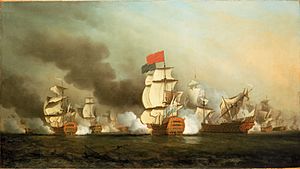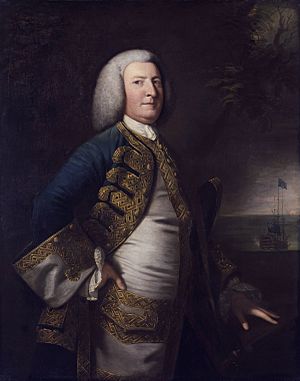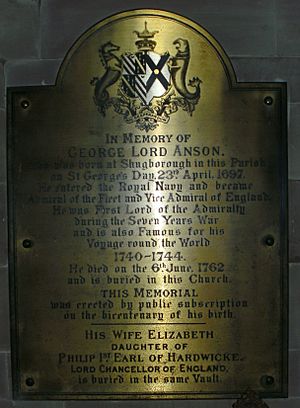George Anson facts for kids
Quick facts for kids
The Lord Anson
|
|
|---|---|

Portrait of Lord Anson by Thomas Hudson
|
|
| First Lord of the Admiralty | |
| In office 1757–1762 |
|
| Prime Minister | The Duke of Newcastle The Earl of Bute |
| Preceded by | The Earl of Winchilsea and Nottingham |
| Succeeded by | The Earl of Halifax |
| In office 1751–1756 |
|
| Prime Minister | Henry Pelham The Duke of Newcastle |
| Preceded by | The Earl of Sandwich |
| Succeeded by | The Earl Temple |
| Personal details | |
| Born | 23 April 1697 Staffordshire, England |
| Died | 6 June 1762 (aged 65) Moor Park, Hertfordshire, England |
| Military service | |
| Allegiance | |
| Branch/service | |
| Years of service | 1711–1762 |
| Rank | Admiral of the Fleet |
| Commands | HMS Weazel HMS Scarborough HMS Garland HMS Diamond HMS Squirrel HMS Centurion |
| Battles/wars | War of the Spanish Succession War of the Quadruple Alliance War of Jenkins' Ear War of the Austrian Succession Seven Years' War |
George Anson, 1st Baron Anson (born April 23, 1697 – died June 6, 1762) was a famous officer in the Royal Navy. He became an Admiral of the Fleet, which is the highest rank in the navy. Anson started his career as a junior officer during the War of the Spanish Succession. He later fought against Spain in the Battle of Cape Passaro during the War of the Quadruple Alliance.
One of his most famous achievements was sailing all the way around the world during the War of Jenkins' Ear. He also led the British fleet to victory against the French Admiral de la Jonquière at the First Battle of Cape Finisterre. This happened during the War of the Austrian Succession.
Anson later became the First Lord of the Admiralty. This was a very important job where he was in charge of the entire Royal Navy. He held this position during the Seven Years' War. He made many important changes, like stopping dishonest contractors and improving medical care for sailors. He also introduced uniforms for officers and moved the Marines to be part of the Navy. He even created a new system for ranking ships based on how many guns they had.
Contents
George Anson was born on April 23, 1697, at Shugborough Manor in Staffordshire, England. His father was William Anson. George had seven brothers and sisters. His family had good connections, which helped him in his career.
In February 1712, when he was just 15 years old, Anson joined the Royal Navy. This was during the War of the Spanish Succession. He started as a volunteer on a ship called HMS Ruby. Later, he moved to another ship, HMS Monmouth.
He became a lieutenant in 1716. He served on HMS Hampshire in a fleet that sailed in the Baltic Sea. In 1718, he fought against Spain in the Battle of Cape Passaro. This battle was part of the War of the Quadruple Alliance.
Anson was promoted to commander in 1722. He was given command of a small ship called HMS Weazel. His job was to stop smuggling between Britain and Holland. He did this job very well. Because of his success, he was promoted again to post-captain in 1723. He then commanded HMS Scarborough, which protected British merchant ships.
He continued to command various ships, including HMS Garland, HMS Diamond, and HMS Squirrel. In 1737, he was given command of the 60-gun ship HMS Centurion. He was promoted to commodore and led a group of ships to attack Spanish areas in South America. This was at the start of the War of Jenkins' Ear.
Amazing Voyage Around the World
Anson's journey around the world was full of challenges. His squadron set off later than planned. They faced terrible storms when trying to sail around Cape Horn. Two of his ships, HMS Pearl and HMS Severn, couldn't make it and had to go back home. Another ship, HMS Wager, was wrecked off the coast of Chile. Some of the crew even mutinied.
By June 1741, when Anson reached the Juan Fernández Islands, only three of his six ships were left. These were HMS Centurion, HMS Gloucester, and HMS Tryal. The number of his crew members had dropped from 961 to just 335. Many sailors died from scurvy, a terrible disease caused by lack of Vitamin C.
Even with fewer ships and men, Anson managed to bother the Spanish. He attacked and looted the small port city of Paita in Peru. Because so many of his crew were sick, he gathered all the remaining survivors onto his main ship, HMS Centurion. He rested at the island of Tinian and then sailed to Macau in November 1742.
After some difficulties with the Chinese authorities, Anson sailed again with only HMS Centurion. He was looking for a rich Spanish ship called a Manila galleon. These ships carried goods and treasure between Mexico and the Philippines. On June 20, 1743, he captured the Nuestra Señora de Covadonga. This ship had a huge amount of treasure: over 1.3 million pieces of eight (Spanish coins).
The maps found on the captured ship greatly improved British knowledge of the Pacific Ocean. Anson took his prize back to Macao, sold its cargo, and kept the coins. He then sailed back to England, arriving on June 15, 1744. The money he earned from capturing the galleon made Anson very rich. This also gave him a lot of political power.


In 1744, Anson became a Member of Parliament for Hedon in Yorkshire. He joined the Board of Admiralty in December 1744. He was promoted to Rear-Admiral of the White in 1745 and then to vice-admiral of the blue. He took command of the Western Squadron, a group of ships, in July 1746.
"Sir, you have vanquished the Invincible and Glory follows with you."
In May 1747, Anson led his fleet to defeat the French Marquis de la Jonquière at the First Battle of Cape Finisterre. This was during the War of the Austrian Succession. Anson's forces captured the entire French squadron, including four large warships and six merchant ships. The treasure they captured was worth £300,000. For his great success, Anson was made a noble, becoming Lord Anson, Baron of Soberton, in June 1747.
In 1748, a book about Anson's voyage around the world was published. It was called Voyage Round the World in the Years MDCCXL, I, II, III, IV. The book was a huge success and very popular. Anson was promoted to admiral of the blue in 1748 and became Vice-Admiral of Great Britain in 1749. He became the Senior Naval Lord on the Admiralty Board in November 1749.
Anson became the First Lord of the Admiralty in June 1751. He held this important job during the Seven Years' War. He made many important changes to the Navy:
- He removed dishonest contractors who were cheating the Navy.
- He improved medical care for sailors.
- He updated the Articles of War to make discipline stronger in the Navy.
- He introduced uniforms for all commissioned officers.
- He moved the Marines from the Army to be part of the Navy.
- He created a new system for rating ships based on how many guns they had.
Anson was very worried about a possible French invasion of Britain. He kept a large naval force in the English Channel to protect the country. In 1756, he was criticized for not sending enough ships to help Admiral Byng at Minorca. Anson wanted to protect Britain from invasion, but no invasion happened, and Byng failed to save Minorca.
Anson left the Admiralty briefly but returned in June 1757. In 1758, he took command of the Western Squadron again. He played a key role in stopping a serious French invasion attempt in 1759. He ordered a close blockade of the French coast. This blockade hurt the French economy and made sure no invasion fleet could leave without being seen. British victories at the Battle of Lagos and the Battle of Quiberon Bay in 1759 ended any real hope of a French invasion.
Besides protecting Britain, Anson worked with William Pitt to plan British attacks on French colonies around the world. By 1760, Britain had captured Canada, Senegal, and Guadeloupe from the French. They also captured Belle Île and Dominica in 1761. When Spain joined the war in 1762, Anson helped plan expeditions to capture Manila in the Philippines and Havana in Cuba. He was promoted to Admiral of the Fleet on July 30, 1761. His last duty was to bring Queen Charlotte to England.
Anson died on June 6, 1762, at Moor Park in Hertfordshire. He was buried at St Michael and All Angels Church in Colwich, Staffordshire. Many places and ships have been named after him, including Anson County, North Carolina and eight Royal Navy warships.
Family Life
In April 1748, George Anson married Lady Elizabeth Yorke. She was the daughter of Philip Yorke, 1st Earl of Hardwicke. They did not have any children.
See also
 In Spanish: George Anson para niños
In Spanish: George Anson para niños




